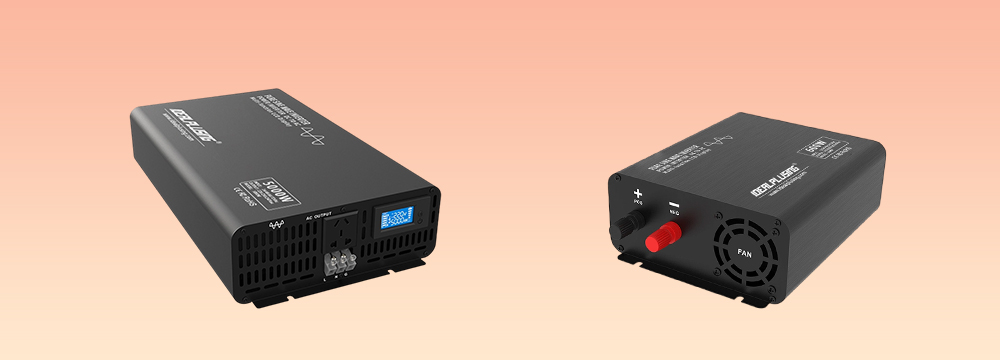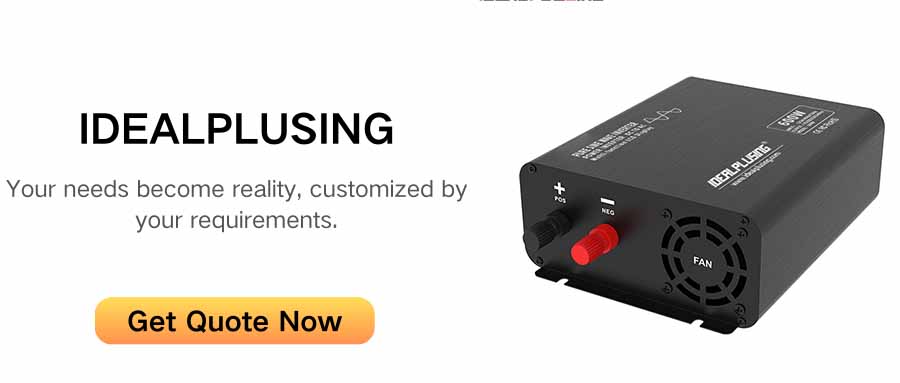Working principle of a sine wave inverter
A sine wave inverter is a power electronic device whose core function is to efficiently convert direct current (DC) into alternating current (AC), and the output AC waveform is close to an ideal sine wave. This inverter is widely used in various fields that require high-quality AC power, such as solar power generation systems, wind power generation systems, UPS uninterruptible power supplies, electric vehicle chargers, etc.
Basic structure
The basic structure of a sine wave inverter mainly includes the following parts:
DC input terminal: Receives power from a battery or other DC power source.
Inverter circuit: The key part of converting DC power into AC power, usually achieved by high-frequency switching technology (such as PWM or SPWM technology).
Control circuit: Responsible for controlling the conduction and shutdown of the power switching devices in the inverter circuit to ensure that the output AC waveform meets the requirements.
Filter circuit: Filters the AC output of the inverter circuit to remove high-frequency noise and harmonic components, making the output waveform closer to a pure sine wave.
Output circuit: The filtered AC power is supplied to the load.
Workflow
The workflow of the sine wave inverter can be summarized as the following steps:
DC input: The inverter receives power from the DC power supply and removes the pulsating part of the DC voltage through the filter circuit to obtain a stable DC power supply.
Inverter conversion: In the inverter circuit, high-frequency switching devices (such as IGBT or MOSFET) are periodically turned on and off under the action of the control circuit. By adjusting the duty cycle and frequency of the switch, an AC signal with the same frequency and amplitude as the mains can be generated. In this process, the inverter circuit uses high-frequency switching technology (such as PWM or SPWM technology) to achieve efficient power conversion.
Filtering: The AC signal output by the inverter circuit usually contains high-frequency noise and harmonic components. In order to obtain pure sinusoidal AC, the output signal needs to be filtered through a filter circuit. The filter circuit is usually composed of inductors and capacitors, which make the output waveform smoother and more stable through filtering and harmonic suppression.
Output AC: The AC signal after filtering is supplied to the load. Since the output waveform is close to a pure sine wave, it can meet the needs of loads with high requirements for power quality.
Advantages and Disadvantages of Sine Wave Inverters
Advantages
High-quality AC output: The AC waveform output by the sine wave inverter is close to the ideal sine wave with low distortion, so it can provide high-quality AC power. This is especially important for equipment that requires stable and pure power (such as precision instruments, medical equipment, etc.).
Low interference and low noise: Since the output waveform is a pure sine wave, the sine wave inverter has little interference and low noise to radios, communication equipment and precision equipment. This helps to protect the normal operation of the equipment and extend its service life.
Strong load adaptability: The sine wave inverter can meet the needs of various types of loads, including inductive loads (such as motors, transformers, etc.) and resistive loads (such as resistors, electric furnaces, etc.). This allows the sine wave inverter to play a good role in a variety of applications.
High efficiency: With the development of technology, the power density and efficiency of sine wave inverters are constantly improving. This enables the inverter to reduce energy loss and improve energy utilization efficiency during the conversion process.
Complete protection functions: Sine wave inverters usually have built-in protection functions such as overload, short circuit, overvoltage, undervoltage, and overtemperature. These functions can cut off the power supply or take other protective measures in time when the inverter is abnormal, to prevent the inverter from being damaged or safety accidents.
Intelligent management: Modern sine wave inverters usually use intelligent management technology, such as intelligent battery management, LCD display, etc. These technologies make the operation of the inverter easier and more intuitive, and can improve the reliability and stability of the inverter.
Disadvantages
High cost: Since sine wave inverters require high-quality materials and advanced manufacturing processes to ensure the pure sinusoidal nature of the output waveform, their manufacturing cost is relatively high. This leads to the market price of sine wave inverters being generally high, which increases the purchase cost of users.
Technical complexity: The working principle of sine wave inverters is relatively complex, and high-frequency switching technology and advanced filtering technology are required to achieve high-quality AC output. This makes the design and manufacturing of sine wave inverters more difficult, and the requirements for technicians are also high.
Difficulty in maintenance: Due to the complex technology and sophisticated internal structure of the sine wave inverter, once a fault occurs or maintenance is required, it is usually necessary to be operated by professional technicians. This increases the maintenance cost and difficulty for users.
Large volume and weight: In order to meet the needs of high power output, sine wave inverters usually need to adopt a larger volume and weight to accommodate more components and heat dissipation devices. This makes the sine wave inverter relatively inconvenient to carry and install.
In summary, the sine wave inverter has the advantages of high-quality AC output, low interference and low noise, strong load adaptability, high efficiency and complete protection functions. However, its high cost, complex technology, difficult maintenance, large volume and weight also limit its application in some fields. With the continuous advancement of technology and the reduction of costs, sine wave inverters are expected to be widely used and promoted in more fields.
IDEALPLUISNG Power Expert:
We focus on the research and development, sales and services in the fields of DC-DC power modules, AC-DC rectifier modules, DC-AC inverters, AC power supplies, DC power supplies, LED power supplies, chargers, rectifier systems, etc., providing personalized, efficient, reliable and cost-effective power solutions for all walks of life.
Thank you for considering our services.







